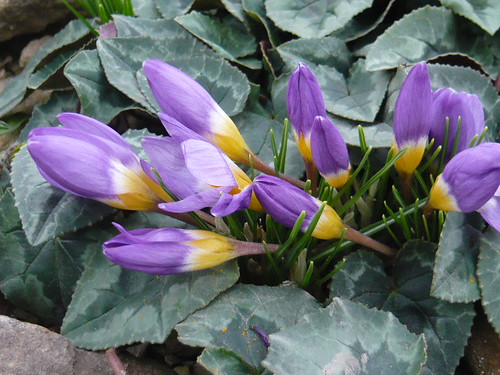Crocus Tommasinianus Ruby Giant
Look around this autumn for Crocus bulbs/corms but include smaller species varieties in your search

Species Crocus
- Crocus tommasinianus (‘Ruby Giant’) is virtually a species Crocus. The bulbs tend to be smaller than many other Crocus varieties, especially from £1 shops!
- Specie Crocus are available in a vast range of varieties and colours. From pastel shades to vibrant blues, violets, yellows or creams.
- Chrysanthus are one of the more popular and prolific species.
- Sieberi includes the triple coloured Tricolour in Yellow, white and lilac blue.
- The sophisticated little flowers open wide wherever they receive full light in late winter and early spring.
- They are popular for naturalising and with early pollinating insects as they have an earlier flowering time.
Ruby Giant Growing Tips
- Ruby Giant crocus is a large flowered variety producing elongated purple flowers in March/April.
- Plant from August until December.
- Bulbs or corms should be planted 5-8cm deep and 10 cm apart.
- Ruby Giant grows a bit taller than many Crocus to around 10-15cm tall.
- Flowers are purple with a lighter center when the petals are open.
- This variety is not too attractive to squirrels but nothing is certain.
- Ruby Giant is a great naturaliser that spreads gently and even grows well in open woodland sites.
Further Crocus Tips
- Crocus bulbs should not be eaten – leave that to mice and squirrels
- For data on Crocus planting depths look at G Tips
- There are 80 or so species of Crocus many of which flower in Autumn.
- Planted too deep or not deep enough can damage flowering. Over the years the bulbs should be pulled to the right depth.
Pound Shop Bulbs
- As mentioned above do not expect top sized bulbs for anything other than top size prices
- Choice of variety is often restricted but you do get quantity for your money.
- Do not leave it too late. Hot shops dry the bulbs out but a fast turnover of stock should prevent this becoming a problem. If in doubt buy elsewhere.
- Planting and growing instructions are often in short supply
- Bulbs can provide a cheap and cheerful splash of spring colour. Pot some up in a container
- They are an impulse purchase in these shops but I was that impulsive buyer ( got several packets).
Flicr top 25 Crocus – Group
‘The genus Crocus is placed botanically in the iris family (Iridaceae). The plants grow from corms and are mainly hardy perennials, and are found in a wide range of habitats, including woodland, scrub and meadows.
There are about eighty species of crocus (of which approximately 30 are cultivated). Their cup-shaped, solitary, salverform flowers taper off into a narrow tube. Their color varies enormously, although lilac, mauve, yellow and white are predominant. The grass-like, ensiform leaf shows generally a white central stripe along the leaf axis. The leaf margin is entire. All crocuses typically have three stamens. The spice saffron is obtained from the stigmas of Crocus sativus, an autumn/fall-blooming species.
The name of the genus is derived from the Greek κÏόκος, krokos (attested in Homer’s Iliad, Book XIV, verse 347), this in turn being a Semitic loanword (Hebrew karkom, Aramaic kurkama, Persian and Arabic kurkum, all meaning saffron or saffron yellow). In Greek, the word is also used for the similarly colored egg yolk.
In cultivation
As one of the first flowers to bloom in spring, the large hybridized and selected “Dutch crocus” are popular with gardeners. However, in areas where snow and frost occasionally occur in the early spring it is not uncommon for early-flowering crocuses to suddenly wither and die from an unseasonable frost or snowfall.
Most crocus species and hybrids should be planted in a sunny position, in gritty, well-drained soil, although a few prefer shadier sites in moist soil. Some are suitable for naturalising in grass. The corms should be planted about 3–4 cm deep; in heavy soils a quantity of sharp grit should be dug in to improve drainage.
Some crocuses, especially C. tommasinianus and its selected forms and hybrids (such as ‘Whitewell Purple’ and ‘Ruby Giant’) seed prolifically and are ideal for naturalising. They can, however, become weeds in rock gardens, where they will often appear in the middle of choice, mat-forming alpine plants and can be difficult to remove.’


2 thoughts on “Crocus Tommasinianus Ruby Giant”
Comments are closed.